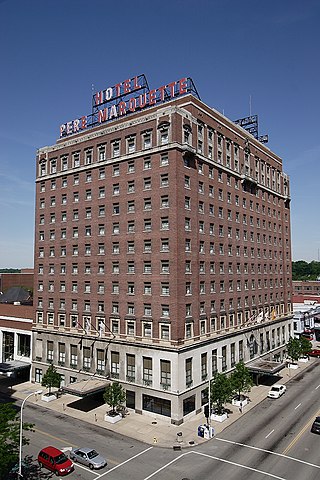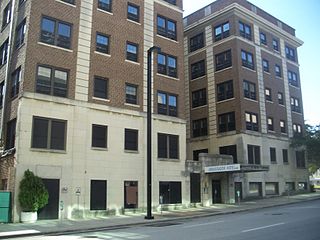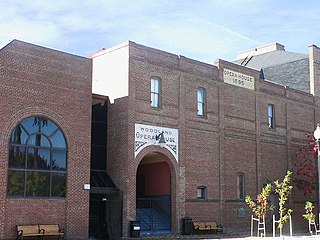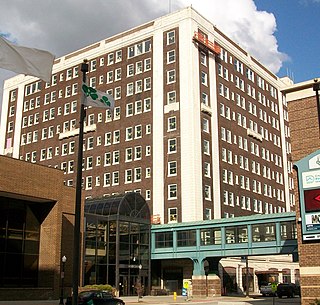
The Automobile Alley neighborhood and Automobile Alley Historic District in Oklahoma City is an upscale Urban area, located roughly along North Broadway Avenue in Downtown Oklahoma City. The district contains numerous low and mid-rise heritage buildings once home to the city's automobile dealerships, that today hosts many of the city's top bars and restaurants, retail shops, and urban residences alongside modern construction consisting mostly of residential housing and hotels. Automobile Alley is listed in the National Historic Register of neighborhoods.

The Peoria Marriott Pere Marquette, is a historic 14-story hotel in downtown Peoria, Illinois, United States. Built in 1926, the building is Peoria's only surviving example of an upscale 1920s hotel. It was listed on the National Register of Historic Places in 1982.

The Lafayette Building was a high-rise office building located at 144 West Lafayette Boulevard in downtown Detroit, Michigan. It was built in 1923 and occupied a triangular lot, bordered by Michigan Avenue, West Lafayette Boulevard, and Shelby Street. The building was 14 floors tall, with one basement floor, and 13 above-ground floors. The office building was designed in the neo-classical architecture style by C. Howard Crane who built many of Detroit's theaters. It is built with mainly brick, limestone, and terra cotta. Its triangular form mimicked the Flatiron Building in Manhattan.

The Bryan Building, which has also been known as the Shepherd Building and as the DeSoto Hotel, is a historic site in Fort Lauderdale, Florida. It is located at 220-230 Brickell Avenue. In 1997 it was added to the U.S. National Register of Historic Places.

The 310 West Church Street Apartments, also known as the Ambassador Hotel, is a historic building located at 420 North Julia Street in Jacksonville, Florida, United States. On April 7, 1983, it was added to the U.S. National Register of Historic Places.

The Sarasota Times Building is a historic site in Sarasota, Florida. It is located at 1214–1216 1st Street. On March 22, 1984, it was added to the U.S. National Register of Historic Places. The three-story asymmetrically-massed, stucco and cast stone façade, Mediterranean Revival structure was designed by architect Dwight James Baum. It is significant to Sarasota's heritage for its role as a newspaper established in 1899, and also for its architectural merits.

The urban development patterns of Lexington, Kentucky, confined within an urban growth boundary that protects its famed horse farms, include greenbelts and expanses of land between it and the surrounding towns. This has been done to preserve the region's horse farms and the unique Bluegrass landscape, which bring millions of dollars to the city through the horse industry and tourism. Urban growth is also tightly restricted in the adjacent counties, with the exception of Jessamine County, with development only allowed inside existing city limits. In order to prevent rural subdivisions and large homes on expansive lots from consuming the Bluegrass landscape, Fayette and all surrounding counties have minimum lot size requirements, which range from 10 acres (40,000 m2) in Jessamine to fifty in Fayette.

Downtown Norfolk serves as the traditional center of commerce, government, and culture in the Hampton Roads region. Norfolk, Virginia's downtown waterfront shipping and port activities historically played host to numerous and often noxious port and shipping-related uses. With the advent of containerized shipping in the mid-19th century, the shipping uses located on Norfolk's downtown waterfront became obsolete as larger and more modern port facilities opened elsewhere in the region. The vacant piers and cargo warehouses eventually became a blight on downtown and Norfolk's fortunes as a whole. But in the second half of the century, Norfolk had a vibrant retail community in its suburbs; companies like Smith & Welton, High's, Colonial Stores, Goldman's Shoes, Lerner Shops, Hofheimer's, Giant Open Air, Dollar Tree and K & K Toys were regional leaders in their respective fields. Norfolk was also the birthplace of Econo-Travel, now Econo Lodge, one of the nation's first discount motel chains.

El Cortez is a condominium building in San Diego, California. Built from 1926 to 1927, the El Cortez was the tallest building in San Diego when it opened. It sits atop a hill at the north end of Downtown San Diego, where it dominated the city skyline for many years and became a landmark hotel.

Elizabeth Bard Memorial Hospital, now known as The Elizabeth Bard Memorial Building, is a historic building in downtown Ventura, California. Built in 1901, it is a Mission Revival structure featuring covered terraces and a covered porch with a three-story bell tower at the southeast corner. The building was listed as Ventura Historic Landmark No. 19 in 1976 and was added to the National Register of Historic Places in 1977.

The Woodland Opera House, listed on the National Register of Historic Places and a California Historical Landmark, is one of four fully functioning 19th century opera houses in California. It is a contributing property to the Downtown Historic District of Woodland, California.

The Woodland Public Library is the oldest, and one of the last functioning Carnegie-funded libraries in California. It is on the National Register of Historic Places and is a contributing property of the Downtown Woodland Historic District.

El Garces Intermodal Transportation Facility is an Amtrak intercity rail station and bus depot in downtown Needles, California. The structure was originally built in 1908 as El Garces, a Harvey House and Atchison, Topeka and Santa Fe Railway (ATSF) station. It is named for Francisco Garcés, a Spanish missionary who surveyed the area in the 1770s. It was added to the National Register of Historic Places in 2002.

The Yolo County Courthouse was a courthouse for the Superior Court of California in Yolo County in Woodland, California until 2015. The original building was erected in 1864, and was used for 37 years until condemned in 1911. The edifice, built in the same location in 1917, was listed on the National Register of Historic Places in 1987, and is also a contributing property in the Downtown Woodland Historic District.

The Dallas Hilton, constructed as the Hilton Hotel and today operating as the Hotel Indigo Dallas Downtown, is a historic hotel opened in 1925, located at the corner of Main Street and S. Harwood Street in downtown Dallas, Texas (USA). The hotel is a contributing property in the Harwood Street Historic District and Main Street District. It is also located across the street from Main Street Garden Park.

The Porter Building is a historic building listed on the National Register of Historic Places located in the Downtown Historic District of Woodland, California.

The Hotel Blackhawk is an eleven-story brick and terra cotta building located in Downtown Davenport, Iowa, United States. It is a Marriott Autograph Collection property.

The Putnam-Parker Block, also known as City Square, are historic structures located in downtown Davenport, Iowa, United States. The property includes three buildings that take up the south half of block 43 in what is known as LeClaire's First Addition. The main façade of the structures face south along West Second Street. They were listed on the National Register of Historic Places in 2011. In 2020, it was included as a contributing property in the Davenport Downtown Commercial Historic District. The former Putnam Building now houses a Marriott Autograph Collection hotel named The Current Iowa.

The Hamilton Hotel is a AAA 4-diamond hotel in downtown Washington, D.C., United States, located at 1001 14th Street, N.W., just to the north of Franklin Square. It is a member of Historic Hotels of America, the official program of the National Trust for Historic Preservation.

The Oil Capital Historic District (OCHD) is an area in downtown Tulsa, Oklahoma that commemorates the success of the oil business in Tulsa during the early 20th century. During this period, Tulsa was widely known as "The Oil Capital of the World." The area is bounded by 3rd Street on the north and 7th Street on the south, Cincinnati Avenue on the east and Cheyenne Avenue on the west.

























